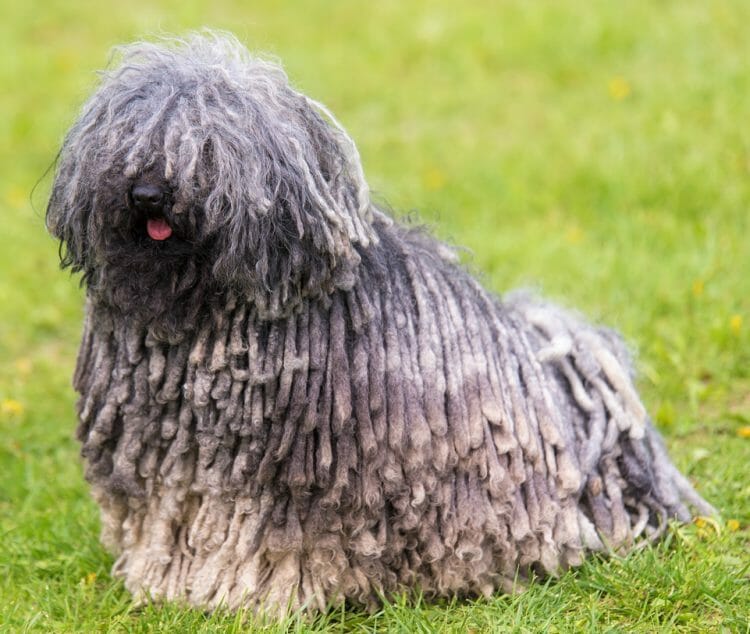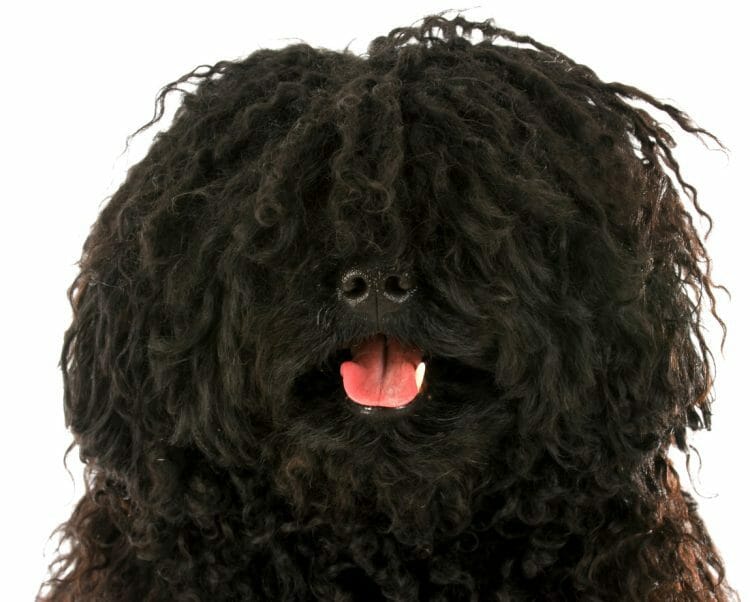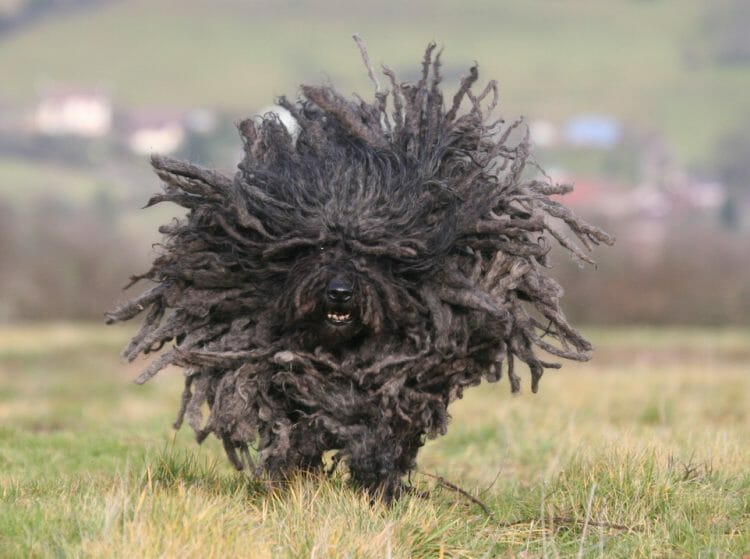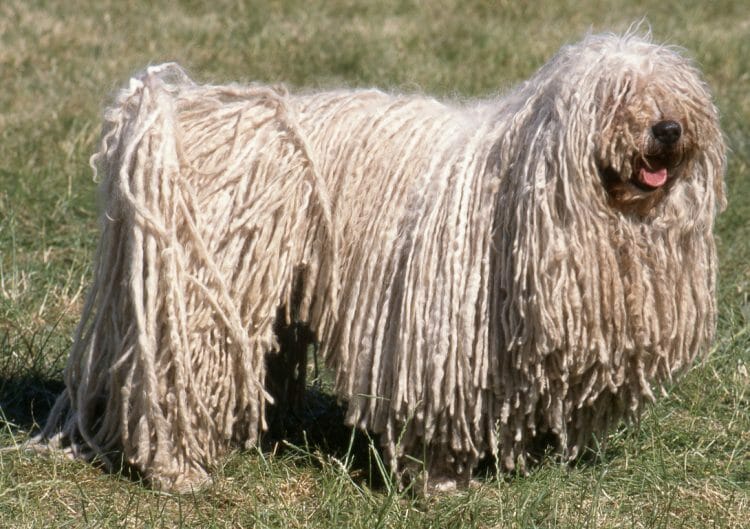Puli Dog

Hungarian Puli Dog Personality
Historically used as a working canine, the Puli dog is both active and highly intelligent. Given its ability to work independently, the Puli needs early socialization and positive reinforcement training to learn desired behaviors. A Puli owner will require confidence to keep these canines in line.
A Puli puppy will be inquisitive and interested in its surroundings. With a natural suspicion of strangers, older Puli dogs are often used as a watchdog. These affectionate canines love to spend time with family members of all ages and may even try to herd them.
The Puli needs outdoor space. Owners will need to have a yard and be prepared to take their dog on long walks. Pulik (the plural form of Puli) that get insufficient exercise may become overactive or shy.

What Does a Puli Dog Look Like?
The Puli dog is usually black and has a solid color that covers the entire body. They are sometimes found in gray, white, or cream. Any white Puli will have dark pigmented skin, black mouths, black noses, and black pads.
The Puli coat is made of either thick or thin cords that can be round or flat. The variations in coat depend on how much undercoat the dog has in comparison to the outer coat. The coat develops through controlled matting. The corded coats that look like dreadlocks are usually desired by owners. Grooming will be required to prevent thin ropes from forming.
As the Puli ages, the cords will become long and may reach the ground. Trimming the coat regularly will make grooming easier. Some people believe that trimming the cords short will prevent future growth. However, this is not the case as the coat will continue to grow even if it is cut. Due to the nature of the coat, this breed does not shed often, which is why they are often included on lists of hypoallergenic dogs.
Standards for the breed state that a female Puli should be 16.5 inches tall, and males should be 17 inches tall. A female will weigh between 23 and 25 pounds, with the males being slightly heavier.

Puli Dog Facts
The Puli dog has a long history going back more than 2,000 years. Some believe that similar dogs existed over 6,000 years ago. However, others claim that the Puli evolved from the Tibetan Terrier.
While excavating for oil in Iraq around the area that used to be ancient Sumer, the remains of a man, his dog, and a sheep were found. Inside their grave, there was also long knotted hair, which closely resembles the cords of a Puli. It is thought that the man was a shepherd who was buried with his most loved sheepdog.
Clay plaques found in Eridu tell of the ancient Sumerian laws regarding animals. In these laws, there are references to Puli and Komondors, both herding dogs with similar appearances. Also, at the excavation site, there was a statue of a Puli in the tomb of a young girl.

Migration to Hungary
The Puli found its way to Hungary approximately 1,100 years ago. The nomadic Magyar tribes were herders that are believed to have originated near the Ural Mountains in Western Russia. It is thought that the shepherds favored black dogs as they were easier to spot amongst the sheep. The Magyars used Puli to gather and drive the sheep, while the larger Komondor served as a guard dog for the herd.
Historically, these dogs would have been expensive, costing a shepherd’s entire year’s wage. Although Pulik were highly prized, the Magyar shepherds had exacting standards surrounding the breed and would cull any animal that lacked the intelligence to carry out its duties. It is believed that this led to the modern Puli becoming such a healthy and intelligent dog.

Modern Breed Development
By the late 1800s, the need for sheepdogs was in decline, and the number of Pulik dwindled. In 1912, a professor of veterinary medicine named Dr. Emil Raitsits, along with Adolf Lendi of the Budapest Zoo, started a program to revive the breed’s fortunes.
The Fédération Cynologique Internationale approved the breed standard for the Puli in 1924 with three categories: working Pulis, show dogs, and dwarfs. A fourth size was recognized in 1935.
As with many European breeds, World War II almost caused the Puli’s extinction. However, numbers started to rise again in the years that followed. In 1936, the American Kennel Club started accepting the dogs for registration. The Puli Club of America was established 15 years later.
Puli Dog Health
There are very few genetic health issues that owners need to be concerned about. Puli dogs are generally healthy and have an average lifespan of 12 to 16 years. Regular check-ups with a veterinarian and receiving recommended vaccines (such as those for rabies and parvo) are recommended. Preventive medications for fleas, ticks, and heartworm will also help keep a Puli healthy and prevent flea infestations and Lyme disease.

That being said, it is always important to learn about conditions that may affect a dog and consult a veterinarian if any of the early warning signs appear. For the Puli breed, possible areas of concern include hip dysplasia, progressive retinal atrophy, and cataracts.
- Hip dysplasia is a problem that affects many medium-to-large dog breeds. A dog with this condition may become lame. The problem arises as the dog is growing from being a puppy into an adult. The hip joint is made of a ball and socket. If these two parts develop at different rates, the size discrepancy can cause friction across the hip, wearing the bones down. A veterinarian will use an X-ray to diagnose the condition. Surgery may be needed to replace the entire hip joint using plastic and metal implants.
- Progressive retinal atrophy is a condition that affects the eyesight of the dog. Sometimes referred to as retinal dysplasia during early onset, the condition is usually identified while the dog is still a puppy. The disease causes the photoreceptor cells of the dog’s retina to either develop abnormally or deteriorate with age. At first, this causes night blindness. However, a complete loss of eyesight will follow. There is no effective form of treatment for this condition.
- Cataracts. As a Puli ages, it may develop cataracts, which is a haze that covers the dog’s eye. Cataracts will progressively worsen until eyesight is completely lost. The only treatment option for this hereditary condition is surgery. A veterinary surgeon will remove the lens from the dog’s eye and replace it with an acrylic or plastic alternative. The procedure may be required on both eyes.



